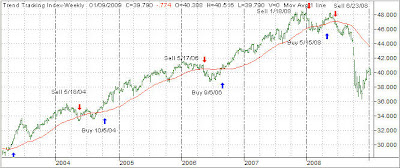 I found this article written by Minyanville’s Peter almost exactly a year ago on January 8, 2008 titled “The Courage To Choose:”
I found this article written by Minyanville’s Peter almost exactly a year ago on January 8, 2008 titled “The Courage To Choose:”
Having been asked to provide my thoughts regarding 2008, I am going to stray a little bit from my usual Buzz & Banter messages and share what I see as the most important theme for 2008 – making choices.
I believe that in time, historians will define the last twenty years in America as the “Age of Aspiration” where, thanks to unprecedented levels of credit, Americans could become anything they wanted. Where, thanks to 0% down debt and a seemingly robust economy, we could own bigger homes, fancier cars, and more lavish vacations – where our bounty was limited only by the boldness of our wants.
Well, I, for one, believe that our Age of Aspiration is ending. And, with its conclusion, we must, for the first time in almost a generation, begin to reconcile our wants with our means. We must choose what to do without, rather than what more to do with.
But I would suggest that few of us are prepared for this challenge. Why? Because abundance relieves each of us from having to prioritize what is important. When anything is possible, everything is possible. Few of us have really had to choose.
As I look ahead to 2008, though, I believe that each of us, the communities we live in, and the organizations and companies we serve, are going to have to make choices. We are going to have to separate what is most important from least, and act accordingly. Where life was once limitless, it will now be constrained. And, like it or not, all of us will need to return to our vocabulary a simple phrase that I believe has been lost over the past 20 years: “I can’t afford that.”
So as we approach 2008, I wish the Minyanville community the wisdom to prioritize well, the courage to make the hard, and often painful, choices, and, most of all, the strength and conviction to follow through.
As we are entering 2009, these words no doubt are as valid as they were a year ago. The country continues to struggle from a sharply deteriorating economy, along with increasing job losses that are unfortunately bound to change the lives for many.
While we can’t change circumstances over which we have no control, we can enter 2009 with the knowledge that we have at least an investment plan in place that has survived the market disaster of 2008. Furthermore, it will provide us with the necessary guidance to deal with another treacherous year in the market.
If the first nine days are any indication of what’s in store, we may see much of a repeat of last year; that is sharp rallies followed by mind numbing drops interrupted by periods of sideways meandering.
In my view, only those investors with an exit strategy, who are big enough to admit when they’re wrong and don’t mind taking small losses in order to avoid large ones, will survive this bear market with their portfolios intact. I hope you will be one of them.






 From time to time, I have quoted Al Thomas, author of the book “
From time to time, I have quoted Al Thomas, author of the book “